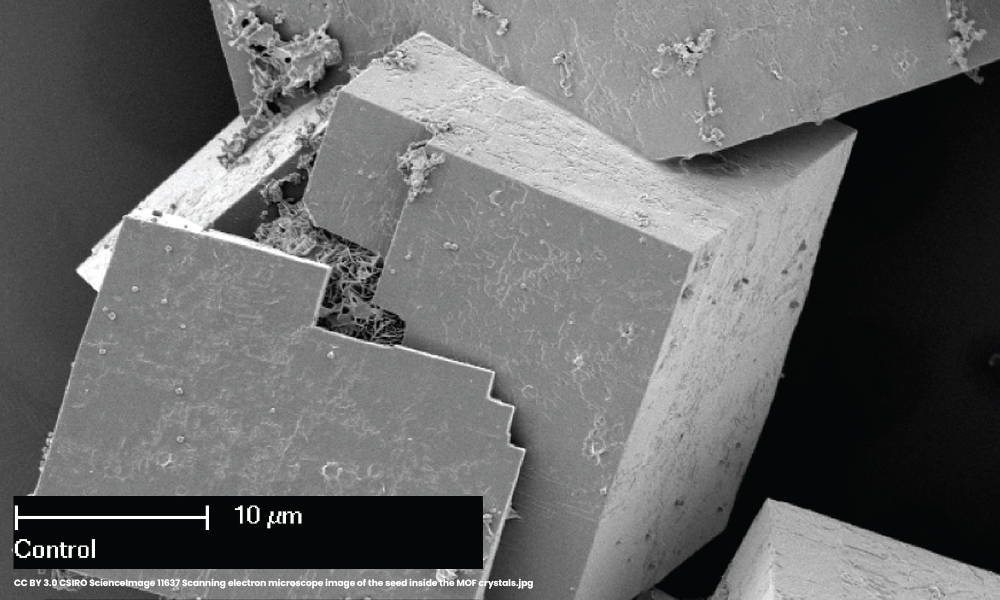
The global environment has been continuously dealing with an increasing amount of pollutants being added. Numerous pollutants which effect the environment to a considerable degree range from radioactive waste, heavy metal waste from mining, oil spills, to green-house gasses which enhance global warming. Due to the increasing presence of these pollutants many fields of science are developing methods to ameliorate the effects caused by these pollutants, as well as methods to enhance detection and sensitivity for these pollutants. As such, nanomaterials have proven to be an interesting approach in dealing with pollutants.
Fossil fuels have become an integral part of modern society, yet the byproducts produced are detrimental to the atmosphere. However, as previously mentioned nanomaterials have been produced to help remediate the effect of these hazardous byproducts. One such nanomaterial is a metal organic framework (Commonly known as an MOF). MOFs are a framework in which typically polymers are linked to one another to form a cube like structure. This structure can then hold a metal atom at the center of the hollow cube. Despite the metal atom occupying the center of the framework, a majority of the space within the MOF is void space (unoccupied area) which makes the MOF an ideal material as a capture agent. Researchers have shown that MOFs can selectively adsorb and capture hazardous byproducts of fossil fuel use such as sulfur dioxide, ammonia, chlorine, tetrahydrothiophene, benzene, dichloromethane, ethylene oxide, and carbon monoxide.
Along with nanoporous materials capturing chemicals hazardous to the environment, nanoporous materials have been created which have the potential to convert the hazardous waste into a more environmentally friendly chemical. For example, CeO2-Pt nanoporous alloys have been found to catalyze the reaction of methanol into carbon monoxide and hydrogen gas. The goal is then to develop a nanoporous material that can catalyze a reaction of a fossil fuel byproduct into a more environmentally friendly chemical. While nanoporous materials have not yet been used to catalyze fossil fuel byproducts into less hazardous materials, the nanomaterials show promise that they can achieve similar results as displayed on methanol.
Organic pollutants are also a major factor in the current environmental pollution problem. However, it has been found that certain materials can be created in which enhance and catalyze the photo-degradation of organic pollutants. Titanium oxide has been found to be an effective catalyst in promoting degradation of organic chemicals through the use of UV-light. A more interesting aspect of the TiO2 material, is that its catalytic properties are able to be enhanced through doping it with various elements, nitrogen being particularly effective. In addition to doping the TiO2 crystal lattice to improve catalytic function, controlling the shape of the photocatalyst has also been found to be a critical component. Researchers have shown that ZnO, another photocatalytic material, is five times more effective at promoting UV-induced degradation of organic pollutants when the ZnO attains a hexagonal platelike structure versus when it has a rod-shaped structure. Such characteristics exhibit how these materials can be fine-tuned in multiple ways to effectively deal with a wide variety of organic pollutants.
Numerous examples of water purification materials have emerged recently due, some of which arose due to the BP oil disaster which occurred in the Gulf of Mexico. Polymers have been of great interest in oil spill remediation, one group has prepared polymer thin film composite membranes coated with amphiphilic graft copolymers consisting of a poly(vinylidene fluoride) backbone and poly(oxyethylene methacrylate) side chains. This ultrafiltration membrane rejects >99.9% of the emulsified oil from an oleic acid/triethanolamine/water microemulsion solution. Along with this selective polymer membrane, nanowire membranes have been created that are selective in binding with oils up to 20 times the weight ratio of water and can be resuspended in solution and be used again for multiple cycles.
Sensing of pollutants and hazards has become equally important in developing ways to deal with the pollutants. Supramolecular molecules have been developed which have selective binding to the specific pollutant of interest and can then be detected. One such example is the development of rigid three dimensional pentiptycene moieties to conjugated polymers, which remain fluorescent even in the solid state due to suppressed chromophore aggregation. However, in the presence of 2,4,6-trinitrotoluene (TNT) or 2,4-dinitrotoluene the fluorescence is quenched and a quantitative reading of the analytes present can be obtained. This system has been employed as a mine detector due to its high sensitivity to TNT vapors. Unique systems to detect heavy metal pollutants have been created, such as a cubic Fm3m nanostructured cagemonolith modified with organic chromophores at their inner pore surfaces that can sense toxic heavy metal ions such as Pb2+, Cd2+, Sb2+, and Hg2+ at subnanomolar concentrations.
An absolutely EXCELLENT review paper on the topic: K. Ariga, S. Ishihara, H. Abe, M. Lia and J. Hillab, J. Mater. Chem., 2012, 22, 2369.
